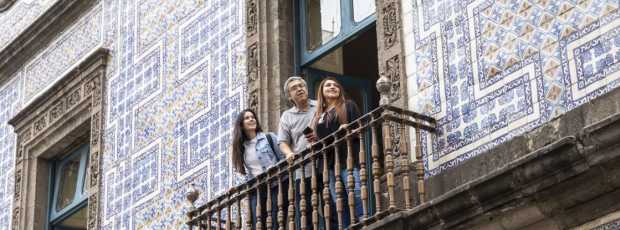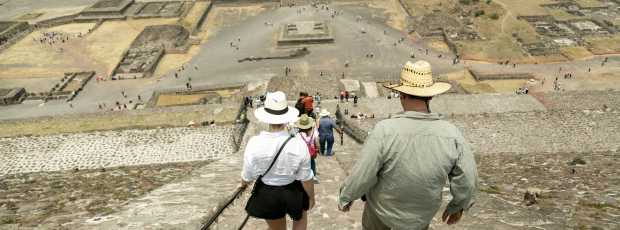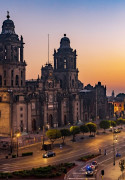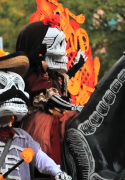Maxel delivered a walking tour that was worth every minute. He knew the history and the local context, but more importantly he made the city feel alive. He set the pace, checked in often, and adjusted the route based on our interests without wasting time.Jalen, Mexico City, 2025
Table Of Contents
- Classic Day Trips You Cannot Skip
- Nature and Outdoors Escapes
- Food and Market Day Trips
- Historic and Cultural Towns
- Seasonal and Festival Trips
- Overrated Day Trips, With Smarter Tweaks
- Practical Tips
- Frequently Asked Questions
I'm Jorge, I've lived in Mexico City for thirty years, and I learned early that even people who love one of the largest cities in the Americas need regular exits.
Not weekend getaways or vacation planning, just day trips and Mexico City experiences that let you breathe different air and return home the same night.
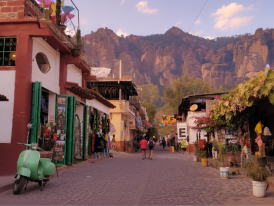
A street in Tepoztlán at sunset
My first escape happened during a July heatwave in 2003 when the pollution turned the sky beige and my apartment felt like an oven. I took a bus to Tepoztlán on a Tuesday morning, hiked up to the pyramid, and came back that evening feeling like I'd taken a week off. That single day reset something essential.
Since then, I've made these trips part of my routine. Some I've done dozens of times, others just once or twice.
What follows is what actually works when you live here and need reliable ways to step outside the capital's rhythm without the hassle of overnight logistics.
Mexico City Experiences Created by Locals, Just for You
See the city through the eyes of the people who call it home.

Tepozteco pyramid perched on cliff edge with valley view behind
Classic Day Trips You Cannot Skip
These are the Mexico City day trips that work for almost everyone, the ones I recommend when someone asks me where to go first. They're popular for good reason, not because travel blogs repeat them, but because they deliver reliable experiences that justify the effort of leaving the city.
Teotihuacán: Worth the Early Alarm
I set my alarm for 5:30 AM on a Saturday last month to beat the crowds to Teotihuacán. By 7 AM I was at the Pyramid of the Sun before opening crowds; as of 2025, summit access is restricted. Two hours later, tour buses arrived and the whole place transformed into a slow-moving river of selfie sticks.
Logistics at a Glance
Best mode: Bus from Terminal Norte to the site entrance or drive (typically 45 minutes to 1 hour, can stretch to 90 minutes in heavy traffic)
One-way time: 1 to 1.5 hours depending on traffic
Cost context: Bus about MXN 120–140 round trip; site entry MXN 100; pulque at roadside stands \~MXN 30–50
Note: As of 2025, the Pyramid of the Sun is closed to climbing; limited access to lower tiers of the Pyramid of the Moon may be allowed, confirm with onsite staff.
The ancient pyramids here are massive, genuinely massive in a way that photographs never quite capture. The Pyramid of the Sun is one of the largest ancient pyramids, and climbing the summit isn't currently permitted.
The Avenue of the Dead stretches for over two kilometers, lined with platforms and smaller pyramids that once formed the ceremonial heart of Mesoamerica's largest ancient city.

Early morning view from Pyramid of the Sun
Is Teotihuacán Better Early or Late?
Early, absolutely early. The site opens at 8 AM, and if you arrive by then you get cooler temperatures, better light for photos, and space to actually experience the scale of the place. By 11 AM on weekends it feels like a theme park. This is easily the most popular day trip from central Mexico for good reason.
On your way back, stop at one of the roadside restaurants that serve weekend barbacoa cooked in underground pits.
The lamb is fall-apart tender, and they serve it with fresh tortillas, consommé, and little cups of pulque if you want to try the ancient fermented agave drink. Indigenous people have been making pulque in this region for thousands of years.
Takeaway: Go early for the pyramids, stay for the barbacoa on the way back.
Teotihuacán Is Not Just Another Place on the List
Experience it through hidden corners and stories most visitors miss.
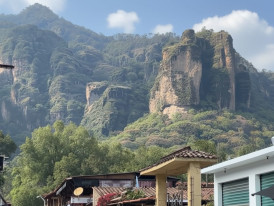
View of Tepoztlán's jagged volcanic cliffs
Tepoztlán: Every Local's First Escape
Tepoztlán sits in a valley surrounded by jagged volcanic cliffs about an hour south of the city. I've been going to this magical town since the early 2000s, and the place has changed, more weekend crowds, pricier restaurants, but the core experience remains solid.
Logistics at a Glance
Best mode: Bus from Terminal del Sur or drive (typically 1 to 1.5 hours, traffic affects weekend timing)
One-way time: 1 to 1.5 hours
Cost context: Bus around 170–210 pesos one way, itacates (wrapped snacks) 40 to 60 pesos, market meals 80 to 150 pesos
The pyramid of Tepozteco sits on a cliff above the charming town center, and the hike up takes about an hour if you're in decent shape. The trail is steep, rocky, and exposed to sun, but every switchback opens up wider views of the valley below.
At the top, the small pyramid feels almost secondary to the panoramic views of mountains and farmland that stretch across three valleys.
What makes Tepoztlán work as a quick trip is that the town itself gives you plenty to do after you descend. The Sunday market spreads through cobblestone streets around the main plaza, selling everything from handwoven textiles to carved wooden masks at the mercado de artesanías.
I usually skip the tourist shops and head straight to the food stalls for itacates, thick corn masa stuffed with beans, cheese, or squash blossoms and wrapped in leaves for portable eating.

Pulque being poured from a gourd
Where to Find Real Pulque in Tepoztlán
Three pulquerías operate on side streets off the main plaza. They serve pulque straight from barrels, slightly sour and foamy, the way people have been drinking it here for centuries.
Ask for a curado if you want it mixed with fruit, though I prefer it plain to taste the actual fermentation.
On weekdays this pueblo mágico keeps its local rhythm. Weekends bring crowds from the capital, and the main streets get congested with slow-moving tourists and Mexico City residents looking for a quick escape.
If you can visit Tuesday through Thursday, you'll see the version of Tepoztlán that people who live there actually experience.
Takeaway: Weekday visits give you the best version of this town, weekend trips mean sharing the experience with half of Mexico City.

Turquoise thermal pools cascading down white limestone terraces
Nature and Outdoors Escapes
I started taking these trips after realizing that spending all my time in concrete and smog was making me irritable. The mountains and thermal springs around Mexico City offer genuine wilderness experiences without requiring camping gear or multi-day commitments.
Grutas Tolantongo: Full Day Commitment, Total Reset
Grutas Tolantongo demands your whole day and gives you back something you didn't know you needed.
I went there in 2015 with my sister after she broke up with her boyfriend of six years, and we spent eight hours alternating between hot springs and cold mountain air until all the tension from months of relationship drama just dissolved.
Logistics at a Glance
Best mode: Bus from Terminal Norte to Ixmiquilpan, then local transport (or drive if you're comfortable with mountain roads)
One-way time: 3 to 3.5 hours total
Cost context: Bus to Ixmiquilpan \~MXN 150; local transport \~MXN 50–80; entry MXN 230 per person per day (cash only); basic meals \~MXN 100–150
The thermal hot springs emerge from the mountainside and cascade down limestone terraces in a remote canyon northeast of the city.
The water stays warm year-round, heated by geothermal activity, and the pools are arranged at different levels so you can find spots ranging from crowded party atmosphere to quiet contemplation in the mountains.

Simple plate of grilled meats and tortillas from Restaurante Paraíso Escondido at Grutas Tolantongo
Is Grutas Tolantongo Worth a Day or Overnight?
You can do it as a day trip if you leave Mexico City by 6 AM and accept that you'll get home around 9 PM exhausted but deeply relaxed.
Staying overnight at the on-site hotel cabins lets you experience the springs at dawn when mist rises off the warm water into cold mountain air, but adds cost and planning.
The main grotto is a cave where you can walk back into the mountain with warm water flowing around your legs and steam rising to the rock ceiling. It's dark and echo-y and feels like being inside the earth's heating system.
I've been back three times since that first trip, and each time I discover some new pool or cave I missed before in these mountains.
Bring water shoes because the rocks are slippery. Bring cash because nothing here takes cards. The on-site restaurants serve simple food, mostly grilled meat and tortillas, but when you've been soaking for hours everything tastes incredible.
Takeaway: Tolantongo requires the longest travel time of any trip on this list and delivers proportional reward for people who commit to the full experience.
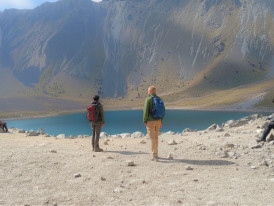
Laguna del Sol sitting in the volcano's collapsed summit
Nevado de Toluca: Alpine Hiking \~2–3 Hours West
Nevado de Toluca is a dormant volcano with two crater lakes near the summit at 4,200 meters elevation. I did the crater rim hike last September and spent the first twenty minutes trying to remember how to breathe in thin air.
This national park offers some of the best alpine landscapes accessible from the city.
Logistics at a Glance
Best mode: Drive (public transportation requires bus to Toluca city, then taxi to the national park entrance, adding complexity)
One-way time: 1.5 to 2 hours to Toluca, then 45 minutes up mountain roads
Cost context: Gas and tolls around 400 pesos round trip; park entry - check current fee (typically \~MXN 58–150); hire local guide optional at 500 to 800 pesos
The drive takes you through pine forests in the mountains that gradually thin out as elevation increases. By the time you reach the parking area near the crater, you're in alpine territory with short grasses and volcanic rock.
The air is noticeably thinner, and even short walks leave you breathing hard. The winter months from December to February can bring snow to the upper reaches of Nevado de Toluca.
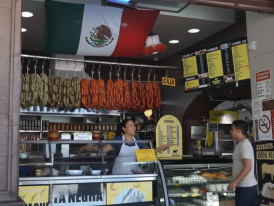
Toluca market stall with chorizo verde
How Hard Is the Nevado de Toluca Crater Hike?
The basic route from parking to crater rim takes about 30 minutes at a slow pace. The challenge isn't technical difficulty but altitude.
People who live at sea level often feel lightheaded or nauseous up here. Take it slow, drink water, and turn back if you feel more than mildly uncomfortable during the climb.
If you're driving, stop in Toluca city center on the way for chorizo verde or chorizo rojo from market stalls. The local sausage here is different from anywhere else in Mexico, bright green from herbs or deep red from chiles, and eating it feels like participating in something specifically Tolucan.
Toluca is located about ninety minutes west of Mexico City and makes an excellent stop before heading to the national park.
Weather changes fast at this elevation in the mountains. I've seen sunny mornings turn to sleet in under an hour. Bring layers, bring rain gear, and check conditions before you go because the access road closes when snow makes it impassable.
Takeaway: Nevado de Toluca gives you high-altitude mountain experience closer to the city than anywhere else, but respect the elevation and come prepared.
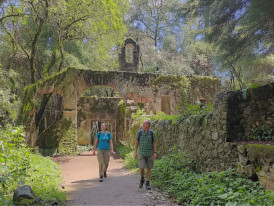
Old monastery ruins in the forest at Desierto de los Leones
Desierto de los Leones: Forest Escape Within an Hour
Desierto de los Leones is a forested national park in the mountains west of the city. "Desierto" refers to a monastic retreat; "Leones" most likely comes from the León family surname (origins are debated). At about an hour from most Mexico neighborhoods, it's easily accessible for a quick trip.
Logistics at a Glance
Best mode: Drive or taxi (around 45 minutes to 1 hour from central neighborhoods)
One-way time: 45 minutes to 1 hour
Cost context: Park entry free, monastery tour 40 pesos, forest food stands 50 to 100 pesos (check current museum fee on arrival/official site)
This national park offers pine forest hiking trails, picnic areas, and the ruins of an old monastery that you can explore and walk through.
It's a popular destination with Mexico City residents on weekends, and the food vendors who set up near the entrance sell quesadillas, coffee, and atole.
I come here when I want a quick nature reset without the commitment of a full-day trip to other destinations in the region.
The air smells like pine and damp earth, the temperature drops noticeably compared to the city, and an hour of walking through forest trails clears mental cobwebs better than anything else I've found nearby in the mountains.
Takeaway: Desierto de los Leones delivers forest immersion and cooler air in under an hour, making it the easiest nature escape from the capital.

Colorful trajineras lined up along canal bank
Food and Market Day Trips
My city has incredible food, and what to eat in Mexico City could occupy its own guide, but some of the best eating experiences require leaving the capital entirely.
These trips justify themselves on food alone, with everything else as bonus material.
Xochimilco: Floating Food Culture
Xochimilco operates simultaneously as tourist attraction and genuine social space for chilangos. I've been there for friend's birthdays, family celebrations, and random Sunday afternoons when we just wanted to drink beer on a boat for a few hours and explore the canals.
Logistics at a Glance
Best mode: Metro to Tasqueña Station, then light rail to Xochimilco (or drive and park near embarcadero, typically 45 minutes to 1 hour)
One-way time: 1 to 1.5 hours by public transportation, 45 minutes to 1 hour driving
Cost context: Metro MXN 5; Tren Ligero MXN 3; trajinera official rate MXN 750 per boat per hour (capacity varies); floating food vendors \~MXN 50–150 per item
The trajineras, flat bottomed boats painted in bright colors, navigate canals that have existed since Aztec times. These aren't tourist props, they're actual working boats used for agriculture and transport.
The chinampas (floating gardens) that line the canals still produce flowers and vegetables for city markets around Mexico City.
What Should You Actually Eat in Xochimilco?
The floating vendors sell elotes (grilled corn), micheladas (beer with lime and spices), quesadillas made on portable griddles, and sometimes full meals of mole or barbacoa.
Quality varies wildly. I stick to things cooked in front of me and skip anything that's been sitting in the sun for hours.
Mariachi bands float past offering to serenade your boat for 100 to 200 pesos per song. The musicians are skilled, many have been working these canals for decades, and hearing them perform in the middle of the water beats any formal concert venue in the world.
Saturday and Sunday bring crowds that turn the main channels into floating traffic jams. Tuesday and Wednesday offer a different experience, quieter water, more space, and you can actually hear the birds in the trees that line the banks and spend time relaxing.
If you're looking for evening entertainment, Mexico at night offers plenty without leaving the city limits.
Takeaway: Xochimilco works best when you treat it like a long lunch with friends rather than a tourist attraction to check off.
Curious What You Won’t Find Online in Xochimilco?
Discover the side only locals talk about.

Cross-section of overstuffed cemita sandwich with layers visible
Puebla: Cemitas and Mole Poblano
Puebla demands a separate trip focused entirely on eating. This colonial city southeast of the capital claims to have invented mole poblano, and whether that's historically accurate or not, the versions served here set the standard. The historic center of Puebla ranks among Mexico's finest examples of colonial architecture.
Logistics at a Glance
Best mode: First-class bus from Terminal TAPO or drive (highway is direct and well-maintained, about two hours)
One-way time: 2 to 2.5 hours
Cost context: Bus around 200 pesos one way, cemitas 60 to 100 pesos, full mole meal 150 to 300 pesos, Talavera pottery from 200 pesos to several thousand
I went to Puebla specifically to eat cemitas for the first time in 2012. These massive sandwiches layer sesame-studded bread with breaded meat, avocado, cheese, chipotles, and pápalo (an herb that tastes soapy until suddenly it doesn't, and then you can't imagine cemitas without it).
The city center around the main plaza is where you'll find the best traditional restaurants.
The best cemita stands cluster near the Mercado de Carmen, operating from mid-morning until supplies run out.
Order the one with milanesa, ask for everything on it, and accept that you'll need napkins and possibly a second shirt before you head back.
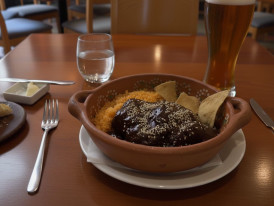
Traditional mole poblano in clay bowl with sesame seeds
When Can You Get Chiles en Nogada?
Late August through September is chile en nogada season. These poblano peppers get stuffed with picadillo (ground meat with fruits and spices), covered in walnut cream sauce, and scattered with pomegranate seeds.
The colors match the Mexican flag, and the dish shows up everywhere during independence day season. Outside those weeks, most restaurants don't serve them because ingredients aren't at peak.
Puebla's centro histórico deserves walking time between meals. The Talavera workshops let you watch artisans hand-paint the blue-and-white ceramics that cover buildings throughout the city center. Each piece goes through dozens of steps, and the good ones cost accordingly.
The main attractions include the cathedral, the Biblioteca Palafoxiana, and numerous historical sites throughout the colonial district.
Takeaway: Go to Puebla hungry, leave room for cemitas and mole, and time your visit for late summer if chiles en nogada matter to you.
Hungry to Try Mexico City Yourself?
Taste and explore the flavors locals actually love.
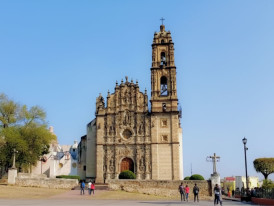
Tepotzotlán church façade
Historic and Cultural Towns
Colonial Mexico exists in layers throughout the valley, and some of the best preserved examples sit just outside the tourist circuit. I prefer these towns precisely because they haven't been scrubbed clean for visitors.
Tepotzotlán: Colonial Architecture Without Crowds
Tepotzotlán sits about an hour north of the city, and most people drive past this small town on the highway without realizing it's there. I discovered it by accident in 2008 when my car overheated and I pulled off to find a mechanic near the town center.
Logistics at a Glance
Best mode: Bus from Terminal Norte or drive (typically 45 minutes to 1 hour)
One-way time: 45 minutes to 1 hour
Cost context: Bus around 60 pesos one way, museum entry about MXN 100, lunch at local restaurants 100 to 200 pesos

Ornate baroque church interior with gold altar and detailed ceiling
The Museo Nacional del Virreinato occupies a former Jesuit college built in the 1600s and represents one of the finest historical sites in the region. The baroque church attached to the museum is one of the most elaborately decorated colonial buildings I've seen in Mexico.
Every surface has carved details, gilded sculptures, or painted imagery. It borders on overwhelming, which was exactly the point when Jesuits built it to impress indigenous people with the power of their religion.
Why Don't More People Visit Tepotzotlán?
It's too close to the city to feel like an adventure and too far to visit casually. That's actually its advantage. On weekdays you'll have the museum mostly to yourself, and the town plaza operates for locals rather than visitors from the capital.
The small restaurants around the plaza serve standard Mexican comfort food, nothing fancy, but the mole is solid and portions are generous. I usually stop at one of the nieverías (ice cream shops) for a scoop of mamey or guanábana before I head back to the city.
Takeaway: Tepotzotlán gives you colonial architecture and museum quality without fighting crowds or inflated prices.
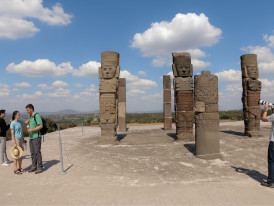
Tula site sculptures and pillars
Tula: Atlantean Warriors Without the Tourist Crowds
Tula sits about 90 minutes north of Mexico City, and most people skip it because Teotihuacán gets all the attention.
I went there on a Wednesday afternoon in 2017 and had the main plaza almost entirely to myself, which meant I could actually hear the wind moving through the stone columns.
Logistics at a Glance
Best mode: Bus from Terminal Norte or drive (about 1.5 to 2 hours depending on traffic)
One-way time: 1.5 to 2 hours
Cost context: Bus around MXN 80–100 one way, site entry about MXN 90, local food stands MXN 60–120
The site centers on the Atlantean warrior figures, four-meter-tall stone columns carved to look like Toltec warriors. They're not as massive as Teotihuacán's pyramids, but standing underneath them creates a different kind of impact.
These figures held up the roof of a temple more than a thousand years ago, and now they just stand exposed on top of Pyramid B looking out over farmland.
Why Does Tula Feel So Different from Teotihuacán?
Scale and crowds. Teotihuacán sprawls across kilometers and attracts thousands daily. Tula fits into a compact area you can cover in two hours, and on weekdays you might share the site with maybe a dozen other people.
The historical sites here feel less curated, more like ruins you discovered yourself.
The small museum near the entrance has carved panels and friezes that provide context for what the Toltec capital looked like at its peak. I usually spend about thirty minutes there before heading to the pyramids.
The town of Tula de Allende sits nearby with basic restaurants serving comida corrida if you need lunch before heading back to the city.
Takeaway: Tula delivers pre-Hispanic ruins and warrior sculptures without requiring you to navigate crowds or tour groups.
Taxco built its economy on silver mining since the 1700s, and hundreds of silver shops still line the narrow streets around the main plaza.

Taxco hillside of white houses and terracotta roofs
Taxco: Silver Town in the Mountains
Taxco climbs up a mountainside about three hours south of Mexico City, and the entire historic center looks like colonial Mexico preserved in silver shops and cobblestone streets.
I went there for a weekend in 2009 and spent most of Saturday just walking uphill and downhill through neighborhoods where every turn revealed another church or plaza.
Logistics at a Glance
Best mode: First-class bus from Terminal del Sur (Estrella de Oro or similar)
One-way time: 2.5 to 3 hours
Cost context: Bus around MXN 300–400 one way, silver jewelry from MXN 200 to thousands, meals MXN 150–300, hotel if staying overnight MXN 800–2000
The town built its economy on silver mining since the 1700s, and hundreds of silver shops still line the narrow streets around the main plaza.
The quality ranges from mass-produced tourist pieces to serious artisan work. If you know anything about silver hallmarks and craftsmanship, you can find incredible pieces. If you don't, it's easy to overpay for mediocre work.
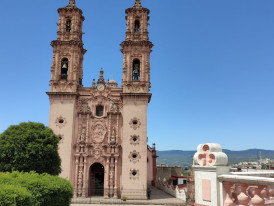
Taxco's Santa Prisca cathedral
The Santa Prisca cathedral dominates the main plaza with its churrigueresque facade covered in carved stone details.
Inside, the gold-leaf altar work represents some of the finest baroque religious art in Mexico. I'm not particularly religious, but walking into that space makes you understand why colonial churches invested so heavily in overwhelming visitors.
Is Taxco Better as Day Trip or Overnight?
Overnight if you can manage it. The town transforms at night when day-trippers leave and locals reclaim the plazas. The best restaurants open for dinner, and walking the steep streets under streetlights gives you a completely different perspective.
You'll spend six hours on buses for maybe four hours in town, which works but feels rushed.
The cable car (teleférico) runs from the town up to Hotel Monte Taxco, offering panoramic views of the valley and mountains. It costs around MXN 100 round trip and takes about ten minutes. Some people skip it, but the views justify the cost if you want to see how dramatically the town cascades down the mountainside.
Takeaway: Taxco rewards overnight stays more than rushed day trips, but even a few hours walking the silver district beats staying in Mexico City.
Too Many Lists, Not Enough Clarity?
We make exploring simple by connecting you with someone who knows the city and helps you spend your time on what matters to you.
See how it works
San Ángel's Saturday art market
San Ángel: Colonial Village Inside the City
San Ángel sits in the southern part of Mexico City, technically within city limits but maintaining its own distinct colonial character. I lived nearby for two years in the late 1990s and spent Saturday mornings at the art market in Plaza San Jacinto watching vendors set up before tourists arrived.
Logistics at a Glance
Best mode: Metro to M.A. de Quevedo, then short walk or taxi to Plaza San Jacinto (or drive, about 30–45 minutes from central neighborhoods)
One-way time: 45 minutes to 1 hour by public transportation
Cost context: Metro MXN 5, market art from MXN 200 to thousands, museum entries MXN 50–100, lunch MXN 150–350
The Saturday art market (Bazar Sábado) brings painters, sculptors, and craftspeople to Plaza San Jacinto to sell work directly.
Quality varies dramatically, from amateur watercolors to serious pieces by established artists. I've bought several pieces over the years, and the best strategy is to arrive early, walk the entire market once to see everything, then circle back for serious negotiations.
The neighborhood itself preserves colonial architecture better than most of Mexico City. The Museo del Carmen occupies a former Carmelite monastery with mummified bodies in the crypt (genuinely mummified, not tourist props).
The Casa del Risco has an elaborate courtyard fountain made entirely from antique ceramics and plates embedded in the wall.
Restaurants around Plaza San Jacinto serve upscale Mexican food in colonial courtyards. San Ángel Inn is the most famous, expensive and formal, with waiters in traditional dress. I prefer the smaller places on side streets where locals actually eat lunch and prices reflect neighborhood reality rather than tourist expectations.
Takeaway: San Ángel gives you colonial atmosphere and serious art shopping without leaving Mexico City proper, making it perfect for Saturday mornings when you want culture without long bus rides.
What If You Could See Mexico City Through Local Eyes?
Go beyond guidebooks with someone who actually lives here.
Seasonal and Festival Trips
Some destinations only make sense during specific windows when natural events or cultural celebrations transform them into something worth the journey. I plan my calendar around a few of these every year.
Día de Muertos in Mixquic: Late October and Early November
Mixquic is a small town southeast of the city that goes all-in for Día de Muertos. The cemetery transforms into a candlelit memorial with thousands of marigold petals covering graves and families spending the night with their deceased relatives.
Logistics at a Glance
Best mode: Drive (public transportation requires multiple connections) or organized tours
One-way time: Around 1.5 hours
Cost context: Entry to cemetery free, food vendors 50 to 100 pesos
I went on November 1st a few years ago and arrived around 8 PM when the cemetery was already packed with families laying out elaborate ofrendas.
The smell of copal incense mixed with marigolds, candles flickered across hundreds of graves, and a band played traditional songs near the entrance. Locals and visitors spend hours here on this night.
This only works if you're visiting Mexico City during late October or the first few days of November. Outside those dates, Mixquic is a regular small village with limited appeal to most travelers.
Takeaway: Mixquic offers one of the most authentic Día de Muertos experiences near the capital, but only matters during the actual holiday.
Monarch Butterfly Sanctuaries: Mid-November Through March
The monarch sanctuaries northwest of the city operate from mid-November through March when millions of butterflies cluster in oyamel fir forests.
I went to the Rosario sanctuary in January, hiked up the mountain path, and reached the section where butterflies covered entire tree branches in orange masses that shifted and rustled in the sun.
Logistics at a Glance
Best mode: Drive or organized tours (public transit requires bus to Zitácuaro or Angangueo, then local transport)
One-way time: Around 2.5 to 3 hours
Cost context: Entry 80 pesos, optional guide 200 pesos, warm clothes essential
The hike to the butterfly zones takes 30 to 45 minutes at altitude in the mountains. When the sun hits the trees and warms the butterflies, they start flying and the air fills with orange wings.
It's one of those experiences that sounds overhyped until you're standing in it and can explore this natural phenomenon.
Takeaway: The butterflies only appear during specific months, so this requires planning around their migration schedule.

Coyoacán's market tostadas piled high with ceviche and toppings
Overrated Day Trips, With Smarter Tweaks
Not every popular destination lives up to its reputation, at least not the way most people experience it. Sometimes the best discoveries are the hidden gems in Mexico City itself rather than places two hours away.
I've learned these lessons through disappointing trips, and now I approach these places differently or skip them entirely.
Coyoacán: Skip the Museum Lines, Explore the Neighborhood
Coyoacán appears on every Mexico City itinerary because of the Frida Kahlo Museum, or Casa Azul. I've been once, waited 90 minutes in line, shuffled through crowded rooms, and left thinking the whole experience felt more like obligation than enjoyment.
The Casa Azul has become one of the main attractions in the world for Frida Kahlo fans, but the neighborhood offers more than just museums.
Keep: The neighborhood's cobblestone streets, weekend markets, and food scene around the historic center
Tweak: Buy Casa Azul tickets online weeks in advance if you must see it, or skip it entirely and visit other cultural sites
Alternative: Visit the Leon Trotsky Museum three blocks away, it has shorter lines, and Trotsky's house preserves the bullet holes from his assassination
Coyoacán works better as a food destination. The market stalls serve tostadas piled with ceviche, carne apache (raw beef with lime and spices), and agua de tuna (prickly pear water).
The vendors have been there for decades, and the quality stays consistent. Beautiful gardens surround the main plaza where you can walk and spend time between meals.
Takeaway: Treat Coyoacán as a lunch destination with optional museum time rather than a pilgrimage to the Casa Azul.
Want to Experience Coyoacán Firsthand?
Step into the neighborhood with someone who knows it inside out.
Valle de Bravo: Better as Overnight, Rushed as Day Trip
Valle de Bravo is a lakeside town about two hours west that everyone recommends for day trips and weekend escapes. I've tried it as a day trip twice and both times felt rushed and unsatisfying. The drive is beautiful through the mountains, but the timing doesn't work well for a single day.
Keep: The scenic drive through mountains, the lakeside setting, the weekend market
Tweak: Stay overnight at a hotel to actually enjoy the lake activities and evening atmosphere
Alternative: If you only have one day, Nevado de Toluca gives you mountain scenery with less driving and no pressure to do water sports or horseback riding
Valle works best when you can spend Saturday and Sunday there, rent a boat, eat long meals, and wake up to morning light on the lake.
It means four hours of driving for maybe three hours at the destination, which locals who've made the trip will tell you feels rushed.
Takeaway: Valle de Bravo deserves better than a rushed day trip, so either commit to overnight or choose something closer.
Practical Tips
After hundreds of these trips over three decades, I've developed habits that consistently make the difference between frustrating logistics and smooth experiences.
None of this is complicated, but ignoring these basics will cost you time and enjoyment.
Start Early or Accept Crowds
Most of the best day trips from Mexico City improve dramatically with early starts. Buses leave major terminals starting around 6 AM, and traffic out of the city is lighter before 8 AM.
I've learned that leaving my apartment by 5:30 AM means I arrive at destinations before crowds and heat build up.
For popular spots like Teotihuacán and Tepoztlán, arriving by 8 AM on weekends makes the difference between peaceful exploration and navigating tourist traffic. Most Mexicans who regularly take these trips follow this pattern.
Weekday Visits Change Everything
Tuesday through Thursday visits to popular towns like Tepoztlán, Puebla, and Xochimilco show you how these places function for people who actually live there.
Streets are quieter, restaurants serve locals instead of weekend visitors, and everything moves at a more natural pace in the village centers.
Weekends bring crowds from the city. That's not always bad, Xochimilco's party atmosphere works better with lots of people, but if you want to see authentic local life, weekdays win every time. This applies to most destinations in the valley around Mexico City.
Weather and Seasons Matter
The dry season (November through April) gives you the most reliable weather for outdoor trips and tours to the mountains. Mornings are cool, afternoons warm up, and rain is rare.
The rainy season (May through October) means afternoon thunderstorms that can turn hiking trails muddy and make mountain roads sketchy.
High-altitude destinations like Nevado de Toluca get genuinely cold from November through February during the winter months. I've been there when temperatures dropped below freezing and wind made it feel even colder.
Bring layers, bring a real jacket, not just a hoodie, especially for the national park areas.
Summer heat (March through May) makes afternoon visits to places like Teotihuacán genuinely uncomfortable. The pyramids offer no shade, and by Noon the sun is brutal if you're trying to explore historical sites.
Because No Two Travelers Are the Same
We help you shape a city day that matches your pace, your style, and your curiosity, not a fixed route.Transportation Reality
Most destinations connect to Mexico City through four main bus terminals: Terminal Norte (north and northwest), Terminal TAPO (east and southeast), Terminal Poniente (west), and Terminal del Sur (south).
Buses run frequently throughout the day to popular destinations in central Mexico, though exact schedules vary and are subject to change, so arrive at terminals with flexibility built into your plans.
First-class bus service costs more but includes assigned seats, air conditioning, and bathrooms. Second-class buses cost less, stop more frequently, and take longer hours on the road.
Driving gives you flexibility but means dealing with Mexico City traffic, toll roads (usually 100 to 300 pesos round trip), and parking at destinations.
I drive my car about half the time and take buses the other half depending on whether I want to drink at my destination or need the freedom to explore beyond the main attractions.

Relaxation time in the hot springs
Pack Smart
For most day trips I bring:
- Water bottle (Mexico's elevation dehydrates you faster than you expect in the mountains)
- Sunscreen and hat (sun is intense at this altitude)
- Light jacket or hoodie (mornings are cool even in summer)
- Cash (many places don't take cards, especially small towns off the beaten path)
- Comfortable walking shoes (you'll walk and explore more ground than you plan)
- Small backpack (easier than carrying bags through bus terminals)
For hiking trips add real hiking boots, extra water, and snacks. For hot springs add swimsuit, towel, and water shoes. If you plan horseback riding at any destination, long pants help.
Getting Local Guidance
If you're new to navigating day trips or want deeper insight into specific destinations, booking a City Unscripted host can help with logistics and finding spots that don't appear in guidebooks.
They can also provide context about culture and history that transforms a quick trip into something more meaningful.
Plan Smarter, Travel Better
Chat with someone who lives there and avoid wasting time on tourist traps.
Frequently Asked Questions
People ask me variations of the same questions about day trips, usually focused on logistics, safety, and whether specific destinations are worth the effort. Here's what I tell them.
1) Can You Do Day Trips from Mexico City Without a Car?
Yes, most destinations on this list connect to the city through reliable bus service from the four main terminals. Teotihuacán, Tepoztlán, Puebla, Xochimilco, and Tepotzotlán all work well with public transportation. Only Nevado de Toluca and Grutas Tolantongo are significantly easier with a car, though organized tours serve both destinations if you prefer not to drive.
2) Which Day Trip Is Closest to Mexico City?
Xochimilco is technically still within Mexico City limits, making it the closest by distance and easily reached by Metro. You can reach it in under an hour by Metro and light rail. Tepotzotlán and Teotihuacán both sit about an hour away and compete for second place among easily accessible options near the capital.
3) What Is the Best Day Trip for First-Time Visitors?
Teotihuacán gives you ancient pyramids and relatively easy logistics for your first quick trip. Go early, hire a guide at the entrance if you want context, explore the pyramids, and stop for barbacoa on the way back. It hits multiple interests without requiring advanced planning or overnight logistics at a hotel.
4) Are Day Trips from Mexico City Safe?
The destinations in this guide see regular tourist traffic and generally operate safely for visitors and locals. Standard precautions apply: keep valuables secured, pay attention in crowded spaces, and avoid displaying expensive cameras or jewelry. Bus terminals in Mexico City can be chaotic, but millions of people use them safely every year to explore the region.
5) How Much Should I Budget for Day Trips?
Budget day trips (Xochimilco, Tepotzotlán, Desierto de los Leones) run 200 to 400 pesos total including transport and food. Mid-range trips (Teotihuacán, Tepoztlán) cost 400 to 700 pesos. Longer trips (Puebla, Grutas Tolantongo) run 600 to 1,200 pesos including transport, entry fees, and meals at restaurants. Add more if you're buying crafts or taking organized tours to multiple locations.
6) Can You Visit Multiple Destinations in One Day?
Generally no, not comfortably if you want to actually explore and spend quality time. Teotihuacán and Tepoztlán are technically in opposite directions but close enough that you could do both if you started at 6 AM and rushed through each. That sounds miserable. Pick one destination per trip and actually experience it instead of collecting checkmarks.
7) Do You Need to Speak Spanish?
Basic Spanish helps significantly, especially for public transit and ordering food at local restaurants. Bus terminals use Spanish signage, ticket agents may not speak English, and small towns outside the tourist path operate primarily in Spanish. Translation apps work for basic communication, but learning a few key phrases improves every interaction with locals.
8) What Day Trip Has the Best Food?
Puebla wins for food-focused trips with cemitas, mole poblano, chiles en nogada, and traditional sweets. Xochimilco offers fun floating food culture on the trajineras. Tepoztlán has solid market food and pulquerías. Teotihuacán's weekend barbacoa stands serve some of the best lamb I've found near the city, and the culture around food there connects directly to indigenous traditions.
9) When Should You Avoid Popular Day Trips?
Mexican holidays and long weekends bring massive crowds to every popular destination in the region. Semana Santa (week before Easter), Christmas week, and national holidays mean packed buses, crowded sites, and inflated prices at hotels and restaurants. If you can visit during regular weekdays, you'll have better experiences exploring the valley and mountains.
10) How Early Should You Leave Mexico City?
For most destinations, leaving by 7 AM gets you there before mid-morning crowds arrive. For Teotihuacán, aim for 6 AM departure to arrive when it opens. For distant spots like Grutas Tolantongo, 5:30 AM departure is reasonable for the full trip. I know these times sound brutal, but arriving early transforms the quality of every trip and lets you visit and explore before tour buses arrive.
11) Are Day Trips Worth It if You Only Have a Few Days in Mexico City?
If you're only in the city for two or three days, spending one on a day trip means missing significant chunks of what makes the capital interesting. Teotihuacán arguably deserves half a day even for short visits to see the main attractions. Everything else can wait for longer trips when you have more hours to spend. The city itself offers months of exploration in different neighborhoods and historical sites, and the things to do in Mexico City could easily fill a week without repeating yourself.
12) Can Children Handle These Day Trips?
Xochimilco works great for families with the boat rides and open space on flat bottomed boats. Teotihuacán involves significant walking and sun exposure that tires kids. Tepoztlán's pyramid hike is steep and challenging for young children who may struggle with the climb. Grutas Tolantongo has shallow pools perfect for children but requires long travel hours. Consider kids' ages, energy levels, and tolerance for long bus rides to the mountains.
13) What Are the Least Touristy Day Trips?
Tepotzotlán sees mostly Mexican visitors with few international tourists visiting the museums and churches. Nevado de Toluca attracts primarily serious hikers to the national park. Desierto de los Leones functions as a local park rather than tourist destination in the mountains. Even Xochimilco functions more as local social space than tourist destination if you visit on weekdays at Tasqueña Station entrance.
14) Do You Need Travel Insurance for Day Trips?
Standard travel insurance should cover day trips within Mexico and the region. The bigger considerations are personal comfort with risk and health conditions that might be affected by altitude (Nevado de Toluca national park) or long bus rides (Grutas Tolantongo hot springs). Most day trips carry minimal risk beyond normal travel concerns in the world.
15) How Do You Know Which Bus to Take?
Bus terminals have ticket counters organized by destination or company. Go to the terminal that serves your destination's direction (Norte, Sur, TAPO, Poniente), find the counters for your destination in central Mexico, compare departure times and prices, and buy tickets for your trip. Staff at information booths can point you to the right counter if you're confused about which bus or terminal to use.
Final Thoughts
I still take day trips from Mexico City regularly, even after thirty years of living in the largest city in Mexico.
The trips work because they don't demand major planning or multiple days off work. You breathe different air in the mountains or valley, eat different food at local restaurants, and return home the same night with your routine intact, but your perspective slightly shifted.
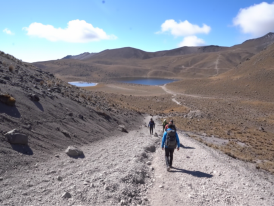
Nevado de Toluca
Choose the best day trips based on what you're escaping or if you're seeking to explore things to do in Mexico City. If you need nature, Grutas Tolantongo hot springs or Nevado de Toluca national park delivers total immersion in landscapes that feel nothing like urban Mexico.
If you want culture and history, Puebla's centro histórico and Teotihuacán offer depth you can spend years exploring.
Start with whatever destination sounds most interesting, leave early, bring cash and comfortable shoes, and see what happens. That's how you'll have a memorable Mexico experience.
More on Mexico City
Ready to Plan Your Perfect Day in Mexico City?
Start your experienceTravel Guides Can Only Take You So Far
City Unscripted connects travelers with locals who shape days that actually fit your interests, not someone else’s checklist.
See how it worksWish You Had a Local Friend in Mexico City?
One who knows the city inside out and could plan a private day just for you? Our local hosts do exactly that: no scripts, no tourist traps, just the side of the city most people miss.




